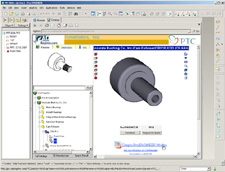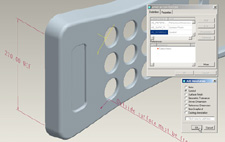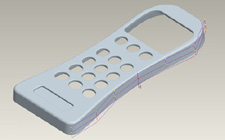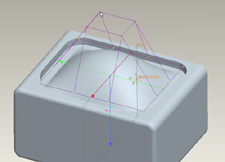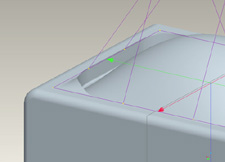Wildfire 2.0: Red-hot or Smoldering?
Enhancements lead this update, but whether you upgrade rests on your current program since shortcomings still remain.
Latest News
August 1, 2004
By Joe Greco
In February of 2003, Needham, Massachusetts-based PTC released its latest incarnationof Pro/Engineer and called it Wildfire. It represented a radical change for PTC:The user interface was redesigned along the lines of a new concept PTC called"The Dashboard,” and new connectivity and modeling capabilities were added. Inmy last review for DE in April 2003, I liked the program in general, but I felt there were certain issues thatneeded to be addressed. Let’s see if they were.
Figure 1: CADRegister.com is now integrated into Wildfire 2.0 and allows usersto drag parts directly into the application. Not every company has 3D components,so Wildfire has a tab for “3D Manufacturers,” a feature that CADRegister.com onthe Internet doesn’t have. |
The Dashboard represented the biggest user interface enhancement for Pro/Engineersince the program’s inception. Not only did it condense all of a particular tool’soptions into one well-designed panel located at the bottom of the screen, butit also replaced the tedious Menu Manager, thus saving a lot of steps. For instance,I counted, on average, 30 percent fewer steps to make simple changes comparedto the last pre-Wildfire release of Pro/Engineer.
But the Menu Manager didn’t completely disappear in Wildfire 1.0 and it stillraises its ugly head in 2.0. For instance, when the program can’t handle a certainedit, in order to resolve the problem, I had to battle the Menu Manager.
There are still many operations that are not clear. For instance, when placinga hole on a model’s surface, Wildfire needs two references—usually the two closestedges. Picking the first one is no problem as Wildfire automatically adds thereference dimension, but when the second edge is selected, the first dimensiondisappears. You have to know to Control-click on this second edge—there are noprompts to do this.
Other tasks still aren’t designed for fewer minimal steps or mouse movements.For instance, after launching the Warp command (discussed below), a prompt inthe Dashboard located in the lower left area of the screen requests that you makea selection (even if there is only one entity to select). After this is done,the next step is to select a plane. However, you won’t be able to perform thissecond step unless you first hit the OK button located in a small, barely noticeabledialog box located in the opposite corner of the Dashboard prompt.
Connectivity/Design Communication Report
Besides user-interface changes, another major aspect of Wildfire 1.0 was a browserthat PTC integrated in the application. The release included a tab called Connections,which provided access to this browser, along with the ability to open files ona local computer or network. The Connections tab also allowed access to variouspart libraries, and soon after the release of Wildfire 1.0, PTC and Thomas Publishingannounced a joint venture.
Figure 3: Turning on the symmetrical option saves time when creating a shapelike this. It’s a feature more programs could use. |
In reviewing Wildfire 2.0, I had the chance to see the fruits of that venture—morethan 50 suppliers from Thomas’s CADRegister.com are fully integrated into Wildfire,along with the ability to drag configured parts directly into the program—a time-savingfeature (see Figure 1, above). It was possible before, but only with catalogsthat were created in Windchill PartsLink, which today still only consists of afew suppliers.
In addition, Trace Parts, a standard component library from France, has alsohooked up with PTC by providing access to configurable parts. However, they can’tdrag into Wildfire—an account has to be set up and the parts are then deliveredvia e-mail.
Figure 4: The goal is to add a bulge to the face that is set back, so I triedWildfire’s new Sculpt option in its Warp tool. Because the face can’t be selected,setting up this edit takes longer and the bulge doesn’t completely encompass theentire face—notice the flat area near the edges. | Figure 4a: Making the editing grid larger causes it to overlap the fillet, whichthen distorts the outer lip. |
Besides catalog updates, connectivity has also been improved with the additionof translators for CATIA V5, Unigraphics NX, and I-DEAS. I imported a CATIA modelwithout a problem and without the need to have CATIA on the computer where Wildfirewas residing. In addition, the file remains associative, using PTC’s associativetopology bus.
Design communication has improved with the addition of a feature called 3D Drawings,based on the new ASME Y14.41 standard. It allows users to add annotations likedimensions, GDandT symbols, and other items usually reserved for the 2D drawing,to a 3D model (see Figure 2, above). Using this was fairly easy, but again I bumpedinto the Menu Manager.
Modeling EnhancementsPTC has improved on the Warp modeling tool it introduced in 1.0 by adding twonew options called Spine and Sculpt. Spine introduces the ability to deform amodel based on either predrawn curve or a selected edge on the model, and allowsthe editing of that curve—hence the model—without leaving the Warp command. Sculptcreates a default 333 grid of points that can be increased for more control, andthen these points can be dragged to shape the model. Once this is done, simplyby hitting a button, those same manipulations can be applied to a different face,which I thought was interesting, albeit somewhat useless.
Picking points could be easier: It’s not possible to window-select; you mustControl-click on each and if you’re not careful, it’s very easy to move the pointsand deform the model before you’re done selecting. An undo fixes this unwanteddeformation, but also deselects all the points, so you have to start over. I likedthe ability to turn on a symmetry option; it is something more programs coulduse (see Figure 3, above), however, it too has its limitations as you’ll readbelow.
A fundamental flaw in the Warp command has not been fixed—the inability to workdirectly on a model face. Instead of picking the face to deform, stretch, sculpt,etc., a workplane is selected, making it very hard to make certain changes (seeFigure 4, above). What’s also confusing is that the selection of this workplanehas little to do with how the option works, as you would expect.
The Transition of WildfireWildfire 2.0 adds some nice new enhancements, but doesn’t address all of theshortcomings of the initial release. So while it’s neither red-hot nor smoldering,should you include it in your future MCAD plans?
If you are using a pre-Wildfire version of Pro/Engineer, then it’s time to upgrade;the new product will surely lead to productivity enhancements with (hopefully)minimal transitional problems. On the other hand, if you’re looking to move from2D, Wildfire is worth consideration but, for the same base price as PTC’s Foundationbundle, there is also SolidWorks, Solid Edge, and Inventor. All have made greaterstrides, functionally, over the past year than Wildfire. And all are still easierto use and a lot simpler to install. In addition, in 2003, all had much greatersales numbers. This raises the issue many in the industry are concerned about:PTC’s long-term viability in the market.
While the company again lost money in 2003, PTC seems to have begun to turn thisaround with a second-quarter 2004 report that showed positive income. The keymay lie in the educational market where PTC has around five million seats. However,only about 60,000 of these are Wildfire seats, the rest are Pro/Desktop, the resultof an aggressive education program that started in 2000. How well, if at all,students make the transition to Wildfire once they begin their professional careerswill be important.
While it’s still too early to see the results of PTC betting the company on Wildfirelast year, we should begin to have an answer by the end of 2004. At that timeWildfire technology will be almost two years old, meaning the 57 percent of Pro/Eusers who didn’t upgrade to Wildfire—perhaps because it was still unproven technologyin their minds—have less of a reason to do so. Also, by the end of the year, we’llknow if the company’s positive income swing continued. Finally, as the fruit ofall those educational installations made over the last several years begins toripen, the effects on Wildfire commercial sales, if any, will be determined.
Joe Greco is a Desktop Engineering contributing editor. You can send Mr. Greco your thoughtson this article c/o reader feedback.
Company InformationPTC - Parametric Technologies Corp.
781-370-5000
website
Subscribe to our FREE magazine, FREE email newsletters or both!
Latest News
About the Author
DE’s editors contribute news and new product announcements to Digital Engineering.
Press releases may be sent to them via [email protected].







